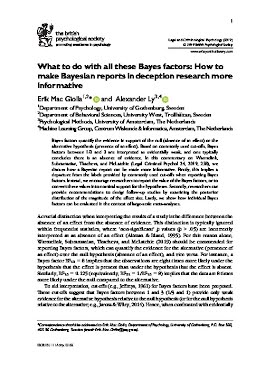2019
What to do with all these Bayes factors: How to make Bayesian reports in deception research more informative
Publication
Publication
Legal and Criminological Psychology , Volume 25 - Issue 2 p. 65- 71
Bayes factors quantify the evidence in support of the null (absence of an effect) or the alternative hypothesis (presence of an effect). Based on commonly used cut-offs, Bayes factors between 1/3 and 3 are interpreted as evidentially weak, and one typically concludes there is an absence of evidence. In this commentary on Warmelink, Subramanian, Tkacheva, and McLatchie (Legal Criminol Psychol 24, 2019, 258), we discuss how a Bayesian report can be made more informative. Firstly, this implies a departure from the labels provided by commonly used cut-offs when reporting Bayes factors. Instead, we encourage researchers to report the value of the Bayes factors, or to convert these values into nominal support for the hypotheses. Secondly, researchers can provide recommendations to design follow-up studies by examining the posterior distribution of the magnitude of the effect size. Lastly, we show how individual Bayes factors can be evaluated in the context of large-scale meta-analyses.
| Additional Metadata | |
|---|---|
| , , | |
| doi.org/10.1111/lcrp.12162 | |
| Legal and Criminological Psychology | |
|
Mac Giolla, E., & Ly, A. (2019). What to do with all these Bayes factors: How to make Bayesian reports in deception research more informative. Legal and Criminological Psychology, 25(2), 65–71. doi:10.1111/lcrp.12162 |
|

